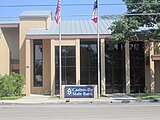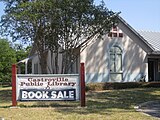Castroville, Texas
Castroville, Texas | |
|---|---|
 Castroville City Hall | |
| Nickname: The Little Alsace of Texas | |
 Location of Castroville, Texas | |
 | |
| Coordinates: 29°20′50″N 98°52′12″W / 29.34722°N 98.87000°W | |
| Country | United States |
| State | Texas |
| County | Medina |
| Incorporated | January 16, 1850[1] |
| Government | |
| • Type | Council-Manager |
| • City Council | Mayor J Darrin Schroeder[citation needed] |
| • City Manager | R Scott Dixon[citation needed] |
| Area | |
| • Total | 2.91 sq mi (7.55 km2) |
| • Land | 2.88 sq mi (7.46 km2) |
| • Water | 0.03 sq mi (0.09 km2) |
| Elevation | 771 ft (235 m) |
| Population (2020) | |
| • Total | 2,954 |
| • Density | 1,000/sq mi (390/km2) |
| Time zone | UTC-6 (Central (CST)) |
| • Summer (DST) | UTC-5 (CDT) |
| ZIP codes | 78009, 78023 |
| Area code | 830 |
| FIPS code | 48-13312[4] |
| GNIS feature ID | 2409411[3] |
| Website | www |
Castroville is a city in Medina County, Texas, United States. Its population was 2,954 at the 2020 census,[5] up from 2,680 at the 2010 census. It is part of the San Antonio–New Braunfels, Texas Metropolitan Statistical Area. Castroville was founded by Alsatian-Texans, who came to Texas during the German emigration period of the mid-1800s. Most Alsatians who came to Castroville spoke Alsatian (a dialect of German origin integrating Celtic, Yiddish, and French words). The Alsatian culture and language are still kept alive by the residents of Castroville.[6] Prior to 1893, Castroville was the first county seat of Medina County.
History
[edit]Castroville was established in 1844 by Henri Castro, an empresario of the Republic of Texas, who brought several dozen European families to the area from Alsace and adjoining Baden to populate his land grant along the Medina River 20 miles (32 km) west of San Antonio. The first colonists disembarked at Galveston on January 9, 1843. They were taken by ship to Lavaca Bay and traveled overland to San Antonio, where they took shelter in abandoned buildings until the Texas Rangers were prepared to escort them to their land and protect them from hostile Indians. On September 2, 1844, the first colonists arrived at Castro's land grant on the Medina River.[7]
From 1849, Castroville, on the Medina River, was a water stop on the San Antonio-El Paso Road and a stagecoach station on the San Antonio-El Paso Mail Line and San Antonio-San Diego Mail Line.
After a few hard years, the town and surrounding farms flourished, but for generations, the residents remained insular. In Castroville's first century, a visitor would be more likely to hear Alsatian—a dialect spoken in Europe before Standard German was prevalent—than English spoken in the town's homes, stores, and taverns. Modern Alsatian travelers noted that the dialect spoken in Castroville was more like that which was spoken in the 1840s. The descendants of the original settlers worked diligently to preserve their language, whose usage in Europe has been diminished by the political actions of France and Germany, especially since World War II.
The Steinbach Haus (originally built between 1618 and 1648 in Wahlbach, Alsace) was dismantled and reconstructed in Castroville in 1998. It was opened to the public in 2002.
Sister cities
[edit]Castroville has two twin towns:
Geography
[edit]Castroville is located 26 miles west of downtown San Antonio.
According to the United States Census Bureau, the city has a total area of 2.5 square miles (6.5 km2), of which 0.39% is covered with water.
Transportation
[edit]U.S. Route 90 runs east-west through the center of Castroville, leading west 16 miles (26 km) to Hondo and east roughly 25 miles (40 km) to downtown San Antonio. The closest airport with commercial airline service is San Antonio International Airport, on the north side of San Antonio 30 miles (48 km) to the east.
Demographics
[edit]| Census | Pop. | Note | %± |
|---|---|---|---|
| 1850 | 366 | — | |
| 1860 | 458 | 25.1% | |
| 1870 | 515 | 12.4% | |
| 1880 | 731 | 41.9% | |
| 1890 | 679 | −7.1% | |
| 1950 | 985 | — | |
| 1960 | 1,508 | 53.1% | |
| 1970 | 1,893 | 25.5% | |
| 1980 | 1,821 | −3.8% | |
| 1990 | 2,159 | 18.6% | |
| 2000 | 2,664 | 23.4% | |
| 2010 | 2,680 | 0.6% | |
| 2020 | 2,954 | 10.2% | |
| U.S. Decennial Census[8] | |||
2020 census
[edit]| Race | Number | Percentage |
|---|---|---|
| White (NH) | 1,620 | 54.84% |
| Black or African American (NH) | 21 | 0.71% |
| Native American or Alaska Native (NH) | 8 | 0.27% |
| Asian (NH) | 19 | 0.64% |
| Pacific Islander (NH) | 1 | 0.03% |
| Some other race (NH) | 10 | 0.34% |
| Mixed/multiracial (NH) | 47 | 1.59 |
| Hispanic or Latino | 1,228 | 41.57% |
| Total | 2,954 |
As of the 2020 United States census, there were 2,954 people, 1,113 households, and 860 families residing in the city.
2010 census
[edit]As of the census[4] of 2010, 3,053 people resided in the city. The population density was 1,045.4 inhabitants per square mile (403.6/km2). The 1,025 housing units had an average density of 402.2 per square mile (155.3/km2).[11]
Of the 941 households, 37.4% had children under 18 living with them, 61.5% were married couples living together, 10.4% had a female householder with no husband present, and 23.5% were not families. About 20.5% of all households were made up of individuals, and 8.7% had someone living alone who was 65 or older. The average household size was 2.74, and the average family size was 3.17.
In the city, the population was distributed as 28.0% under 18, 6.9% from 18 to 24, 27.7% from 25 to 44, 21.7% from 45 to 64, and 15.6% who were 65 or older. The median age was 37 years. For every 100 females, there were 97.2 males. For every 100 females age 18 and over, there were 88.3 males.
The median income for a household in the city was $42,308, and for a family was $51,007. Males had a median income of $35,625 versus $27,228 for females. The per capita income for the city was $20,615. About 5.4% of families and 9.1% of the population were below the poverty line, including 11.9% of those under age 18 and 5.9% of those age 65 or over.
Education
[edit]The City of Castroville is served by the Medina Valley Independent School District and Saint Louis Catholic School (Pre-kindergarten–5th grade).
Gallery
[edit]-
The Steinbach Alsatian House
-
Waders cool off in the Medina River in Castroville.
-
Monument to Henri Castro
-
Castroville State Bank
-
Castroville Public Library
-
Trees shade the entrance to the Landmark Inn, a historic site in Castroville.
-
The Old Alsatian Steakhouse and Ristorante in the historic district of Castroville. The steakhouse closed in 2020.
-
The historic St. Louis Catholic Church is located in downtown Castroville; pastor James Conway (2011).
-
Trailhead at Castroville Regional Park
-
On the hiking trail in Castroville
-
Downtown Castroville, Texas
References
[edit]- ^ Texas (1898). "The Laws of Texas 1822–1897: Austin's Colonization Law and Contract; Mexican Constitution of 1824; Federal Colonization Law; Colonization Laws of Coahuila and Texas; Colonization Law of State of Tamaulipas; Fredonian Declaration of Independence; Laws and Decrees, with Constitution of Coahuila and Texas; San Felipe Convention; Journals of the Consultation; Proceedings of the General Council; Goliad Declaration of Independence; Journals of the Convention at Washington; Ordinances and Decrees of the Consultation; Declaration of Independence; Constitution of the Republic; Laws, General and Special, of the Republic; Annexation Resolution of the United States; Ratification of the Same by Texas; Constitution of the United States; Constitutions of the State of Texas, with All the Laws, General and Special, Passed Thereunder, Including Ordinances, Decrees, and Resolutions, with the Constitution of the Confederate States and the Reconstruction Acts of Congress".
- ^ "2019 U.S. Gazetteer Files". United States Census Bureau. Retrieved August 7, 2020.
- ^ a b U.S. Geological Survey Geographic Names Information System: Castroville, Texas
- ^ a b "U.S. Census website". United States Census Bureau. Retrieved January 31, 2008.
- ^ "Explore Census Data". data.census.gov. Retrieved April 30, 2024.
- ^ "Alsatian Language – Castroville Area Chamber of Commerce". September 21, 2017.
- ^ Wolff, Linda (1999). Indianola and Matagorda Island 1837 – 1887. Austin, Texas: Eakin Press. p. 9. ISBN 1-57168-340-2.
- ^ "Census of Population and Housing". Census.gov. Retrieved June 4, 2015.
- ^ "Explore Census Data". data.census.gov. Retrieved May 20, 2022.
- ^ "About the Hispanic Population and its Origin". www.census.gov. Retrieved May 18, 2022.
- ^ "Archived copy" (PDF). Archived from the original (PDF) on March 15, 2006. Retrieved August 4, 2006.
{{cite web}}: CS1 maint: archived copy as title (link)
External links
[edit]- Castroville, Texas official Page
- Castroville Chamber of Commerce
- https://web.archive.org/web/20110128123337/http://preservecastroville.com/
- https://web.archive.org/web/20090902091004/http://www.castrovilletx.com/castroville-texas-history.htm Castroville Texas City History
- Handbook of Texas Online: Castroville, Texas













